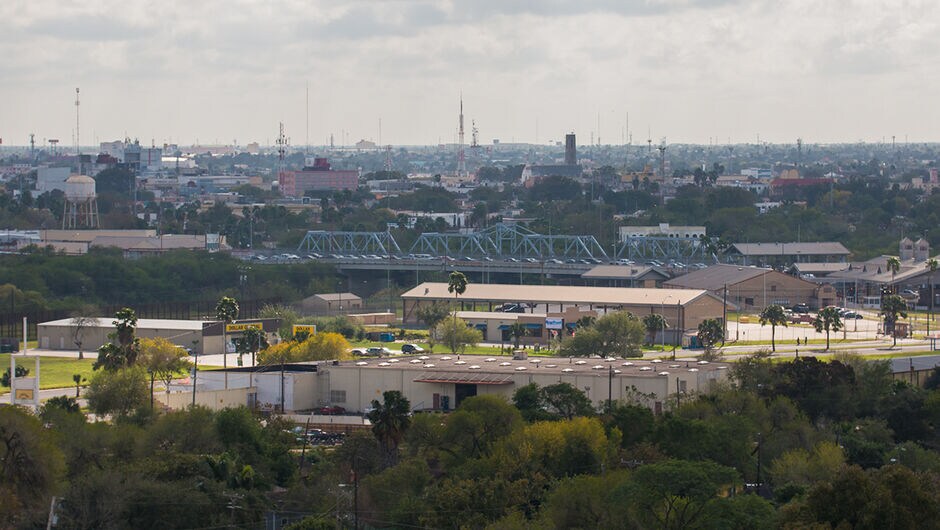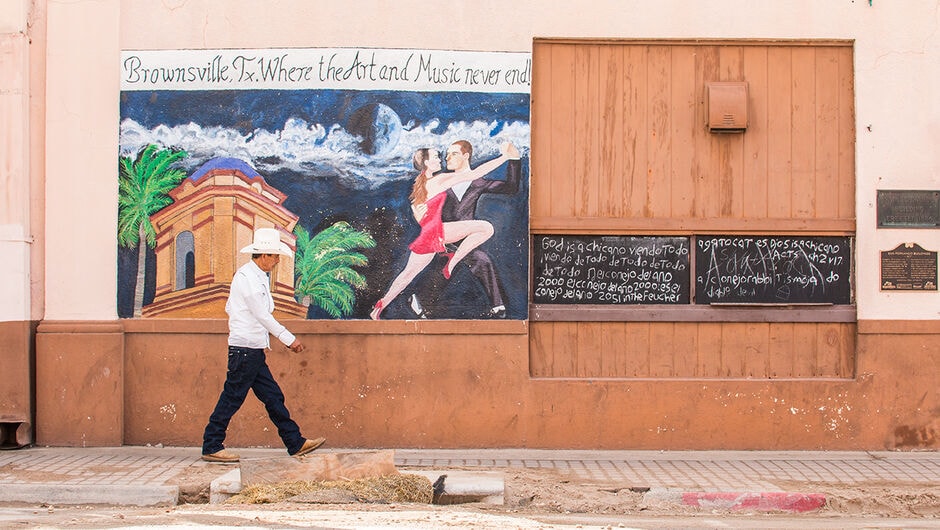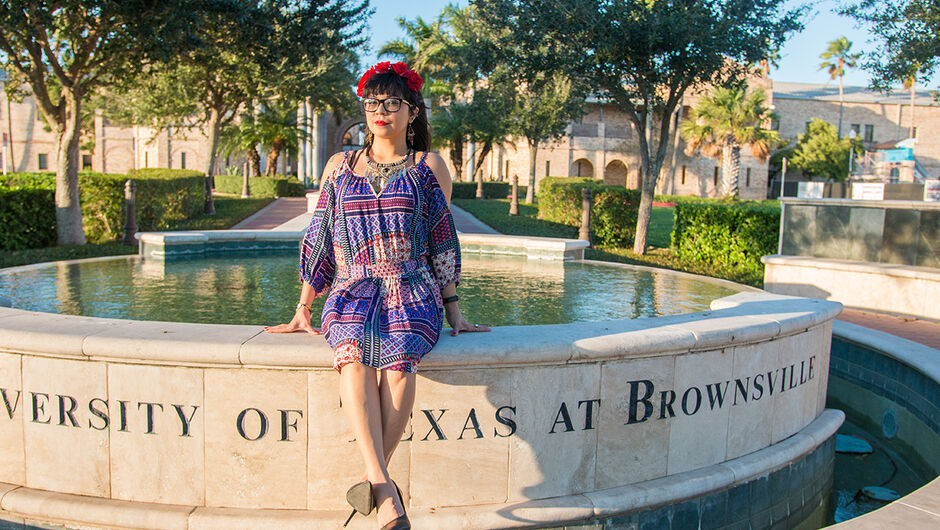
On the Border, a DACAmented Science Teacher Fights On
Brought to Texas as a child, Priscilla Aguilar Lumbreras had to be tenacious to get to where she is as a teacher. She's not giving up.
When 26-year-old Priscilla Aguilar Lumbreras (R.G.V. ’15) says her first year of teaching was her most fulfilling work experience in a young life full of labor, she’s not bragging or trying to curry favor.
For the first time in Priscilla’s life—20 years after she was brought to the United States as an undocumented immigrant and two years after she received protected status under the Obama administration’s Deferred Action for Childhood Arrivals (DACA) policy—she was in a position to pay all her painfully earned wisdom forward.
So from her place in a science classroom at Mercedes High School, about 10 minutes north of the Mexico border in the town of Mercedes, Texas, last year Priscilla printed and distributed DACA qualification checklists to the roughly 10 percent of her students who are undocumented. She encouraged students who qualified to apply, which would let them put their education to work without fear of deportation. She reviewed documents, answered questions, and provided emotional support where her practical expertise was insufficient.
Then the world changed on November 8. It is not entirely clear how the Trump administration plans to treat immigrants currently protected by DACA, or what will happen as their statuses come up for renewal over the next two years. (DACA recipients must reapply every two years.) However, following the presidential election, the National Immigration Law Center (NILC) recommended that applicants who were considering applying for DACA for the first time not do so, warning at the time that it was “unlikely that your application would be processed before the new administration takes power.” If applicants don’t apply, they won’t have to give the government information that could make it easier to deport them. (NILC now recommends that anyone considering applying consult with an immigration attorney.)
Priscilla has followed the NILC’s post-election recommendation. “Now with my students, all I can do is provide support as far as ‘I’m here and you can come talk to me’… emotional support, which to me is terrible. Because when I helped those students last year, I was like, ‘Yes! I wish someone had done this for me,’” she says. This school year, “I’m feeling very—not ‘useless,’ that’s not the word, but… incapacitated, like I can’t help them.”
Seemingly overnight, the lines had shifted and Priscilla was again on the wrong side. She knew the feeling.

I met Priscilla at a café in downtown Brownsville, Texas, after one of the last, long school days before winter break. We sat outside, a few minutes away from the busy pedestrian bridge that carries migrant workers, shoppers, and other travelers across the Rio Grande to and from Matamoros, Mexico, every day. I knew before I met Priscilla the broad strokes of her journey: when she came over, how she’d helped support her family through lean times, how she received protection under DACA after college. But I was unprepared for the force of the story she told, bit by bit, over the next three hours.
Priscilla does not represent or typify the 100 DACA recipients who teach in the corps or the 46 alumni. This is the story of one teacher and how she developed the grit and love of teaching she brings to the classroom.
Priscilla can remember, in an impressionistic way, crossing over to the United States at the age of 5: the motorboat, the shaking, the water all around, her fear. A few months earlier, her father had begun working in Brownsville on a temporary resident visa. He’d arranged for Priscilla and her mother to be brought, discreetly, from their home in Reynosa to the Mexican coast, out far enough into the Gulf to avoid suspicion, then back toward land to be dropped off on Texas’s southernmost shores.
That day, no one came to pick up Priscilla and her mother from the Texas beach. Priscilla remembers sitting with her mother in the heat for hours, trying to stay calm, eventually watching the sun begin to set. At one point, a beach-going family noticed the pair, and the family’s young son came over to share bologna-and-bread sandwiches.
“When I think about that when I’m older now—they obviously knew that we had just arrived, but instead of calling immigration or anything, they just gave us food,” Priscilla says. The act of kindness marked Priscilla’s initiation into a new reality, one she wouldn’t fully understand until more than a decade later. She was an undocumented immigrant, and from that day until now, she’s had to be wary about whether a stranger could become a friend or a threat.
Priscilla and her mother were eventually picked up from the beach and shuttled 20 miles inland to Brownsville to begin their new lives. The family settled on the city’s outskirts in Cameron Park, one of the hundreds of colonias—unregulated, unincorporated settlements, typically without adequate water and sewage service—that dot the U.S.-Mexico border. In the 2000 census, taken in Priscilla’s fourth year of living there, Cameron Park was the poorest community with more than 1,000 residents in the entire country. The streets there are paved, now, but some of Priscilla’s first memories of America are of Spanish-speaking neighborhood boys playing soccer on the colonia’s caliche-surfaced roads, which became “like a dust storm” when cars drove past.

Priscilla spoke no English, and entered an ESL program in kindergarten, where she’d remain until third grade. Her mother—who had completed a technical degree in Mexico that mostly went unused after she ran away from home, fleeing abuse—tutored Priscilla at home to make sure she didn’t fall behind on content while learning English.
The family grew, and shrank. A sister was born, and then three rocky years later, when Priscilla was 9, her father abandoned the family, returning to Reynosa. “The only reason we even came [to the U.S.] was because of him,” Priscilla says, saluting her mother’s next decision. “Imagine making that choice: ‘I’m here alone, literally completely alone. No family… I don’t have support from anyone. But I want my daughters to get a good education.’ And so she stayed.” (Priscilla’s mother and father would reconcile several times, always briefly, adding two younger brothers to the family.)
Priscilla was a top-tier student in high school who joined multiple extracurricular activities. She also began to brush up against the constraints of being undocumented. She couldn’t get a driver’s license. Her best friend—one of only two who knew she was undocumented—moved to San Antonio, and Priscilla was afraid to cross a highway immigration checkpoint to visit her. She tried to back out of taking trips with Interscholastic League—an extracurricular academic competition—but her teachers assured her they would vouch for her. “Every time the checkpoint came up, I was dying; I was just so scared,” Priscilla says. “Scenarios are running through my head… ‘If I get sent back, what’s going to happen to my mom?’”
In 2008, when Priscilla was a freshman at the University of Texas Rio Grande Valley, her mother was sent to prison, and Priscilla, at age 18, became the substitute parent to three siblings, the youngest brother only age 3. Priscilla’s mother had been convicted of negligence after her 13-year-old daughter had become pregnant by the adult son of a family friend.
For the next year, Priscilla took care of her siblings and brought them weekly to the prison for their allotted 15-minute visit with their mother. Until one week, they showed up and learned their mother was gone. She called that night from Matamoros. She’d been released and given a choice: voluntarily walk across the border immediately, or be sent to an immigration detention center to be formally deported. She walked.
Priscilla’s temporary responsibilities became permanent. She woke up by 6 a.m. most days, got her siblings ready for school, took her nephew to day care, and arrived at college in time for class and schoolwork from 9 a.m. to 4 p.m. She’d return home, make dinner, help her siblings with homework until 8 p.m., then head out to her job at The Bar, a bar, where her shift ran until almost 4 a.m. Two hours of sleep later, she’d begin again.
This lasted for four years, until Priscilla graduated cum laude with a degree in biology in 2012.
Meanwhile, Priscilla’s mother opted to stay in Matamoros, where she’d never lived and knew no one, in order to remain as close as possible to her children. The three who were born in the United States—and could thus, as U.S. citizens, freely cross the pedestrian bridge linking downtown Brownsville with Matamoros—visited frequently. Priscilla had to stay on the Texas side.
Having her mother “right there, like two miles away” but being unable to see her “never became normal,” Priscilla says. They spoke on the phone almost every day. “I was always like, ‘I’m going to see you soon, Mom. I’m going to see you soon…’ It was like we kind of needed that to make sure we could keep going.”

On June 15, 2012, on the heels of the failure of yet another iteration of the DREAM Act in Congress, President Obama announced his administration’s new Deferred Action for Childhood Arrivals (DACA) policy, an executive order that would offer temporary, renewable protected status for undocumented immigrants who were brought to the U.S. as children and met certain other eligibility requirements—immigrants like Priscilla.
Priscilla applied as soon as she could, in January 2013. “I felt like all that hope I’d been holding onto, that it was real—that it wasn’t just hope anymore, that it was an actual, tangible path,” Priscilla says. “Like all this struggle was going to dissipate, maybe even a little bit, and that I would finally be able to see my mom.”
Priscilla’s mother’s physical and mental health had declined over the previous few years in Matamoros; she struggled with diabetes and attempted suicide twice.
In March 2013, Priscilla got the call. Her mother—whom she hadn’t been able to see once since she’d been deported—had died in a house fire of unknown origin.
“Everything that had kept me going, all my accomplishments, everything… that was my moment of ‘This is all for nothing,’” Priscilla says. “Like every day telling her, ‘I’m going to see you soon, I’m going to see you soon’—and that moment just never arriving?”
Priscilla’s DACA papers arrived in June.

By the time the Rio Grande gets to Brownsville, the last major city on its route to the Gulf of Mexico, the “big river” is more like a large creek, depleted by irrigation to a shallow span of just 30 or so feet. Most of the other main cities of the Rio Grande Valley—Mission, McAllen, Harlingen—abut the border with Mexico only on their fringes, if at all, but Brownsville is different. Its downtown business district ends, abruptly, at the wall, just north of a wedge-shaped piece of Matamoros that rises like a stalagmite from below.
At the Brownsville café, a few blocks away from the border fence that has contoured almost her entire life, I asked Priscilla what she would do if her DACA status, which is up for renewal in 2017, were revoked without her being deported—if she were required to go back to the way she lived before, hiding in plain sight. She said that’s a line she’s unwilling to cross.
“I feel like I already did it once”—endured sleepless night shifts, shadow-economy wages, perpetual uncertainty—“and it was to get here,” she said. “Now I’m equipped with not only an understanding of myself, but of my goals and what I want from my future.” If she loses her ability to legally study or work in the U.S., she’ll likely return to Mexico and pursue post-graduate degrees in biology.
“I do identify with a lot of other DACA [corps] members when they say, ‘I feel like everything I’ve worked for is for nothing’ and ‘I feel like walls are closing in around me,’” Priscilla said. “They have all these very dark feelings, but for me, it’s like, yes, it would take away basically what I built—but it doesn’t take away everything I’ve learned from it. So there is a positive… You have all this experience and knowledge about the world around you. That can never be taken away from you, no matter if these papers get taken away.”
Experience and knowledge can never be taken away, but they can be withheld. Priscilla made it through. She knows her skills will find use on either side of the border. She will be OK. Now she wonders: Will her students?
Resources
In the Rio Grande Valley:
-
RGV Focus is a local organization that publishes toolkits for teachers and families on navigating higher education in Texas while undocumented.
Resources for Educators Supporting Undocumented and DACAmented Students:
-
Department of Education: Supporting Undocumented Youth Resource Guide is a comprehensive guide created by the Department of Education to provide resources to educators who directly and indirectly support undocumented students.
- The ACLU created a guide to legal rights within schools for Muslim, LBGT and immigrant students and others.
- At The Conversation, find resources on where undocumented students can apply to higher education and where they are eligible for financial aid.
- In addition find Post-Election Resources for Undocumented Students and Families; Post-Election: Recommendations for School Administrators, Educators, Counselors, and Undocumented Students; After the Election: Ideas for Teachers of ELLs
Resources for Undocumented and DACAmented Students
-
Educators For Fair Consideration offers information, resources and legal support for undocumented students in California and throughout the country.
- My Undocumented Life offers updated information, resources, scholarships and relevant news for undocumented and DACAmented students and families.
- United We Dream is the largest undocumented student-led organization in the country.
- Immigration Advocates Legal Directory has compiled a list of organizations that provide trusting, low-costs legal support to undocumented students and families
Stay connected:
-
Find information for DACA Applicants interested in applying to join the corps.
- For more information regarding Teach For America’s DACA Initiative, contact viridiana.carrizales.
Read more about DACAmented corps members and alumni:
Sign up to receive articles like this in your inbox!
Thanks for signing up!
Content is loading...


